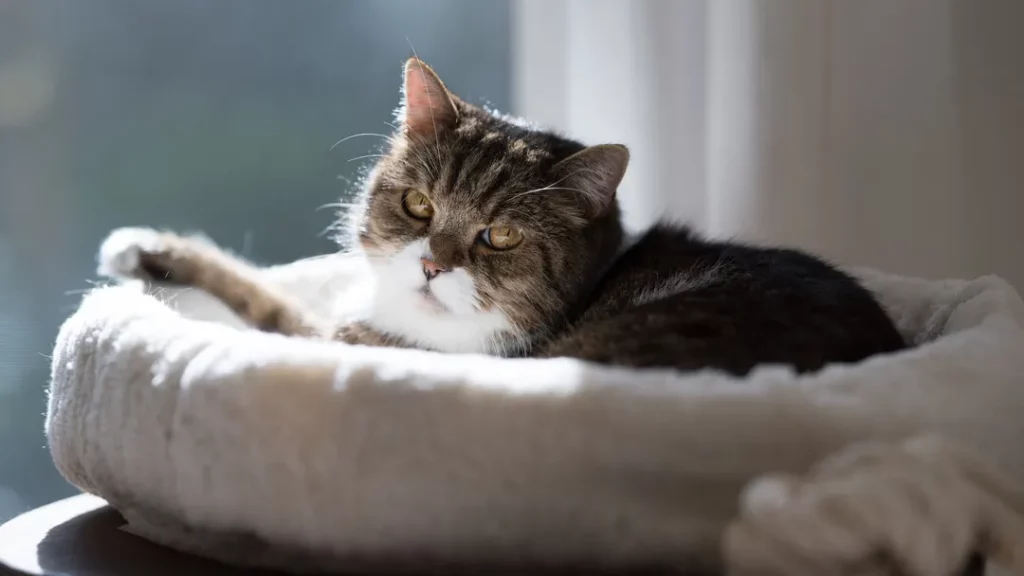Are you curious about knowing how long cats live indoors? Keep reading to know the duration cats can live indoors and outdoors.

Many factors influence a cat’s longevity, and in this comprehensive guide, you will get to learn how long cats live indoors.
Furthermore, our aim is to provide a detailed analysis supported by scientific insights and practical advice to better understand the life expectancy of indoor cats.
How Long Do Cats Live Indoors?
On average, indoor cats can live anywhere from 12 to 20 years or more. This depends on various factors like genetics, diet, environment, and overall healthcare.
In addition, there are some factors that contribute to an indoor cat’s longer lifespan including:
One of them is Safety. Indoor cats are protected from outdoor dangers such as traffic accidents, predators, and various diseases.
Also, regular vet check-ups and preventive care can make indoor cats live longer, leading to better health outcomes.
Another factor is good nutrition, Indoor cats tend to have controlled diets, reducing the risk of exposure to harmful substances or contaminated food.
Lastly, comfort and stress levels affect how long cats can live indoors. Being in a secure, consistent environment typically reduces stress and related health issues for indoor cats.
With proper care, attention, and a safe indoor environment, cats can enjoy a longer and healthier life compared to their outdoor counterparts.
Many indoor cats live well into their teens and some even into their twenties, demonstrating the benefits of a protected and controlled living environment.
How Long Do Outdoor Cats Live?

On average, an outdoor cat’s lifespan can range from 2 to 5 years, but some outdoor cats might live longer, up to 7-10 years or more.
There are several factors that contribute to the shorter lifespan of outdoor cats.
One of them is the cat’s exposure to risks. Interestingly, outdoor cats face various dangers such as traffic accidents, encounters with predators, exposure to toxic substances, and the risk of communicable diseases.
Another factor that can shorten a cat’s life span is health challenges. Outdoor cats might face health challenges like fighting with other animals, injuries, and higher susceptibility to infections due to exposure to outdoor elements.
In addition, when an outdoor cat faces nutritional challenges, it can affect their life span. Their diet might not be as controlled as that of indoor cats, leading to potential exposure to harmful or inadequate food.
Outdoor cats that are well cared for, have access to regular veterinary care, and live in safer areas with lower risks might live longer than average.
However, their lifespan is generally shorter due to the unpredictable and hazardous nature of the outdoor environment.
How Long Do Cats Live in Human Years?
First, you need to know cats age differently than humans. The first year of a cat’s life involves rapid development, and their aging process slows down afterward.
Typically, the first year of a cat’s life is equivalent to about 15 human years in terms of development. After the first year, the aging process slows.
Here is a guideline, a 2-year-old cat is equivalent to about 24 human years
Each year after that: Roughly adds 4 human years.
This means a 4-year-old cat is approximately 32 in human years, a 6-year-old cat is roughly 40 in human years, and so on.
What Percentage of Cats Live to 20?

The percentage of cats that reach the age of 20 or older is relatively low.
While more cats are living longer due to better veterinary care, improved nutrition, and a safer indoor environment, reaching the age of 20 is still considered quite exceptional.
Also, estimates suggest that around 10-15% of cats reach the age of 20 or older.
Factors such as genetics, overall health, environment, and access to proper veterinary care significantly influence a cat’s potential lifespan.
What Percentage of Cats Live to 14?
The percentage of cats that reach the age of 14 is notably higher than those that reach 20 years old.
Furthermore, estimates suggest that a larger proportion of cats, approximately 30-40%, reach the age of 14 or older. This is partly due to improvements in veterinary care among cat owners about providing proper care for their pets.
With improved diets, more cats are now living into their teens and beyond, reaching the age of 14 and even older.
This age, while not as common as younger age groups, is more achievable with proper care and attention to a cat’s well-being.
How Long Do Cats Live Tabby?
On average, tabby cats can live between 12 to 20 years or more. Some may live longer, depending on various elements such as their living conditions and the care they receive.
By providing proper care, a healthy diet, regular veterinary check-ups, and a safe environment, tabby cats can enjoy a lifespan similar to other domestic cats.
The tabby coat pattern itself does not inherently affect their life expectancy.
In conclusion, understanding the factors that influence the lifespan of indoor cats is essential for ensuring they live a long and healthy life.
By providing a safe and stimulating environment we can significantly contribute to the longevity and well-being of our cherished feline companions.
Related Searches:
